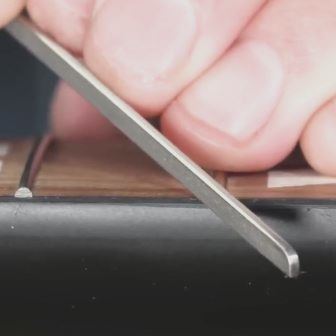Frets play a crucial role in determining the sound and feel of your guitar. They create the notes you hear when you press down on a string, based on their placement along the fretboard. Any wear or damage can directly impact your guitar’s playability and sound quality.

Your DIY electric guitar kit will probably require a little bit of fretwork for the best outcome. Dressing the frets is one of the final steps before setting up your guitar.
The type of wood your fretboard is made from can affect both the tone and durability of your guitar. Common woods include rosewood, ebony, pau ferro, and maple. Each has unique properties, where rosewood is known for its warm tones, and ebony adds a sharper attack. Understanding your fretboard’s material can help tailor its care regimen.
Frets themselves are strips of metal embedded along the fretboard. They guide where strings are effectively shortened to create different pitches. Over time, frets may show wear from frequent play, leading to issues like buzz or uneven sounds.
Recognizing the signs of fretboard wear, visible grooves in frets, or discoloration, means it’s time for some TLC. Regular checks help maintain your guitar’s quality and extend its lifespan, ensuring every session sounds as good as the last.
Links are for specific, high-quality recommended products available at Amazon. There are many options – read the reviews to find the right one for you.
Fretboard Cleaning and Conditioning: Keeping Your Instrument in Tune
Dirt, grime, and sweat can build up quickly on a fretboard, impacting your guitar’s sound and playability. Using a dedicated fretboard cleaner is essential for removing this unwanted debris, ensuring that your guitar stays in top shape.
Conditioning your fretboard is like a spa treatment for your guitar. Hydrating the wood with the right oil helps prevent cracking and drying, particularly for fretboards made of rosewood and ebony. For these woods, lemon or bore oil works wonders, but be cautious with maple. Oils can sometimes stain or damage maple fretboards, so it’s best to avoid them here.
Microfiber cloths are your best friend when cleaning and conditioning your fretboard. These cloths are gentle on the wood and effective at applying products evenly, ensuring no harm comes to the delicate finish. Always opt for a clean cloth to avoid scratching the surface.
When choosing cleaners and conditioners, picking the right product for your specific guitar type matters. A product like Music Nomad’s F-One Oil or Dunlop 65 Fretboard Cleaner (my personal favorite) offers a balance of deep cleaning and hydrating protection. Investing in quality products makes all the difference in maintaining the integrity and appearance of your fretboard.
Fret Maintenance and Polishing: Ensuring Smooth Playability
Fret maintenance is key to keeping your guitar’s sound clear and crisp. Everyday playing can dull the frets, leading to oxidation that affects tone quality. Regular polishing can help restore that smooth, bright sound. Fret erasers like those from StewMac, or polishing cloths like those from D’Addario, make the process simple and effective by gently removing surface gunk without damaging the metal.
Using fretboard guards is a smart move when you’re tackling the frets. These tools shield the wood as you polish, allowing you to focus solely on the frets without worrying about scratches or stains on the fretboard itself.
Steel wool, particularly the 0000 grade, offers a more intensive option for polishing stubborn tarnish on frets. However, it’s crucial to use it cautiously. Tiny metal fibers can easily get caught in guitar pickups, so if your pickups are exposed, consider an alternative method or cover them adequately before using steel wool.
For those frets that are really tarnished, metal polish can rescue their original shine. Products like Flitz or Simichrome can make a big difference by refining the fret surface and bringing back the gleam. A little polish goes a long way, but be sure to buff well to avoid residue that can dull the clarity of your guitar’s sound.
Ongoing Care: Preventing Future Damage to Your Frets and Fretboard
Preventing damage before it starts is one of the best ways to make sure your guitar stays in top condition. A guitar humidifier is an easy yet effective tool in this effort. By maintaining the right humidity levels, it reduces the risk of fret sprout and cracking that dry conditions can cause.
Sharp fret ends can be a real nuisance, especially in varying climates where wood can shrink. A fret end dressing file is handy for smoothing out those irritating edges. It makes playing more comfortable and prevents potential injury from jagged fret wires.
Reducing friction between your strings and frets is another proactive move. Using a string lubricant like Big Bends Nut Sauce or Finger Ease keeps your strings moving freely, minimizing wear over time. This small step not only prolongs the life of your strings but also subtly enhances your playing speed and technique.
Establishing a regular maintenance routine is crucial for long-term care. Regular checks and cleaning sessions help catch small issues before they become costly repairs. Commit to a schedule that includes cleaning, conditioning, and fret maintenance, and your guitar will reward you with consistent performance and a longer lifespan.